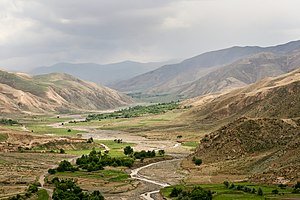
Back قندوز Arabic قندوز ARZ Kunduz (ciudá) AST Künduz (şəhər) Azerbaijani قوندوز (شهر) AZB Ҡондоҙ (ҡала) Bashkir Кундуз Byelorussian Кундуз Bulgarian কুন্দুজ Bengali/Bangla Kunduz Catalan
Kunduz
Persian: قندوز | |
|---|---|
 | |
| Coordinates: 36°43′43″N 68°52′5″E / 36.72861°N 68.86806°E | |
| Country | |
| Province | Kunduz Province |
| District | Kunduz District |
| First mention | 329 BCE |
| Area | |
| • Total | 11,206 ha (27,691 acres) |
| • Land | 112 km2 (43 sq mi) |
| Elevation | 351 m (1,152 ft) |
| Population (2014–2015)[2] | |
| • Total | 268,893 |
| • Density | 2,400/km2 (6,200/sq mi) |
| Population total is estimated | |
| Time zone | UTC+4:30 (Afghanistan Time) |
| Postal code | 35XX |
| Main language | |
| Climate | BSk |
Kunduz (/kʊnduːz/; Pashto: قندوز; Persian: قندوز) is a city in northern Afghanistan and the capital of Kunduz Province. The city has an estimated population of about 268,893 as of 2015, making it about the seventh largest city of Afghanistan, and the largest city in northeastern Afghanistan.[2] Kunduz is in the historical Tokharistan region of Bactria, near the confluence of the Kunduz River with the Khanabad River. Kunduz is linked by highways with Kabul to the south, Mazar-i-Sharif to the west, and Badakhshan to the east. Kunduz is also linked with Dushanbe in Tajikistan to the north, via the Afghan dry port of Sherkhan Bandar. This city is famous in Afghanistan for its watermelon production.
As of 2015, the land use of the city (within the municipal boundary) is largely agricultural (65.8% of total area). Residential land comprises nearly half of the 'built-up' land area (48.3%) with 29,877 dwellings. Institutional land comprises 17.9% of built-up land use, given that the airport is within the municipal boundary.[1]
- ^ a b c "State of Afghan Cities report 2015 (Volume-II)" (in English and Dari). UN-Habitat. 2015. Archived from the original on 26 October 2021. Retrieved 26 October 2021.
- ^ a b "State of Afghan Cities report 2015 (Volume-I English)". UN-Habitat. 2015. Archived from the original on 26 October 2021. Retrieved 26 October 2021.


